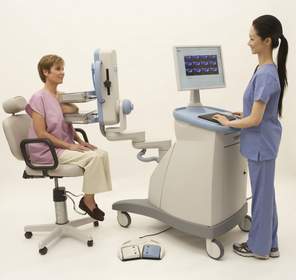SAN DIEGO, CA--(Marketwire - November 19, 2012) - Researchers will present data in three separate presentations on molecular breast imaging. Some of these presentations will highlight the utility and performance of Naviscan's high-resolution organ-specific PET scanner for the detection of breast cancer at the Radiological Society of North America (RSNA) 98th Scientific Assembly and Annual Meeting held November 25 - 30, 2012 in Chicago, Illinois. The presentations will take place Sunday, November 25 in Room S505AB beginning at 11:25 a.m. The breast application of the scanner is commonly known as Positron Emission Mammography or PEM.
Kirti Kulharni, MD, The University of Chicago, will present The Role of Positron Emission Mammography (PEM) in Assessing Axillary Lymph Nodes in Patients with Breast Cancer at 11:25 a.m. - 11:35 a.m. The pilot study showed that PEM has a 98% specificity for the detection of breast cancer loco-regional spread to axillary lymph nodes. The authors conclude that due to this unprecedented specificity, patients with axilla abnormal on PEM could skip sentinel lymph node procedures and the surgeons could assume they have lymph node metastasis.
Wendie A. Berg, MD, PhD, University of Pittsburgh School of Medicine, will present Positron Emission Mammography and Molecular Breast Imaging at 2:00 p.m. - 3:30 p.m. Dr. Berg summarizes the currently approved uses of PEM in this interactive session. Presented uses include local staging, evaluation of the response to primary chemotherapy, and the evaluation for possible cancer recurrence. In addition, exciting areas for future research in high-resolution radionuclide breast imaging will be discussed.
Amy Lynn Conners, MD, Mayo Clinic, will present Breast MR Imaging: Algorithms in Breast Imaging Using BSGI/PEM and MRI Imaging during the 2:00 p.m. - 3:30 p.m. presentation. In this interactive session, Dr. Conners reviews the strengths and weaknesses of breast MR, breast specific gamma imaging (BSGI/MBI) and positron emission mammography (PEM/3D MBI) in the diagnostic and screening settings.
"We value the scientific contributions of these esteemed researchers," stated Paul J. Mirabella, CEO, Naviscan, Inc. "Their ongoing clinical research, publication of the data and mentoring is further proving the clinical utility of PEM and expanding its use among clinicians and patients."
About Naviscan, Inc.
Naviscan, founded in 1995, develops and markets compact, high-resolution PET scanners intended to provide organ-specific molecular imaging and guide radiological and surgical procedures. The Naviscan PET scanner is currently installed and available in breast and imaging centers throughout the world with global distribution in 34 countries. The Company is headquartered in San Diego, California and is the first to obtain FDA-clearance and CE Mark for a high-resolution PET scanner designed to image small body parts and for breast biopsy image guidance. For more information, visit www.naviscan.com.
Contact Information
Joleen Schultz
Naviscan Marketing Communications
321 Medical Launch
Tel: +1.858.455.5500
Email Contact


 Digg this
Digg this Bookmark with del.icio.us
Bookmark with del.icio.us Add to Newsvine
Add to Newsvine


